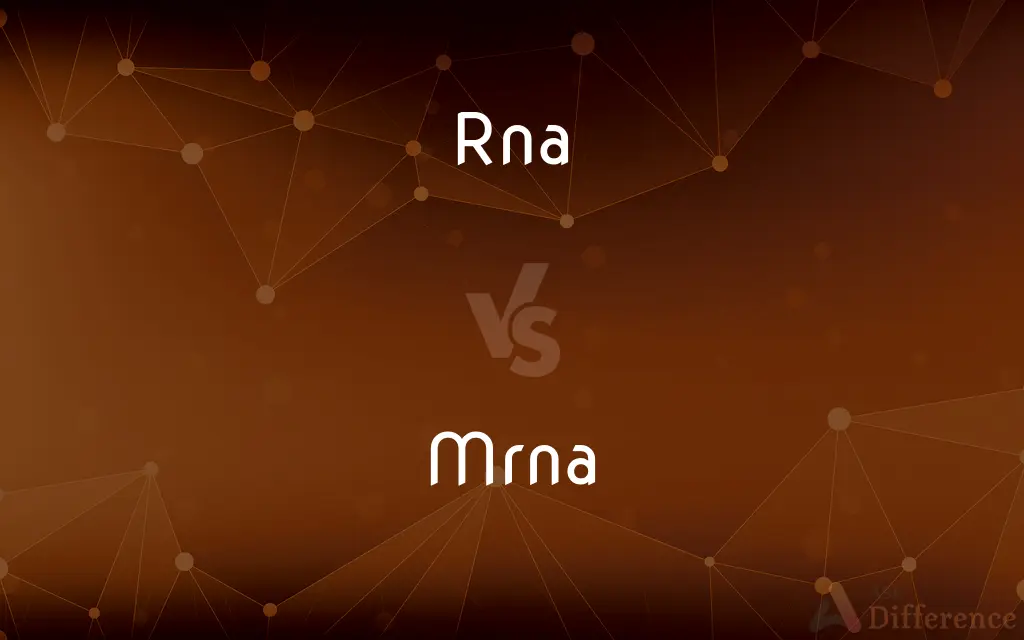RNA vs. mRNA — What's the Difference?
Edited by Tayyaba Rehman — By Fiza Rafique — Updated on October 11, 2023
RNA (ribonucleic acid) is a molecule essential for coding, decoding, and expression of genes. mRNA (messenger RNA) is a type of RNA that carries genetic information from DNA to the ribosome for protein synthesis.

Difference Between RNA and mRNA
Table of Contents
ADVERTISEMENT
Key Differences
RNA, which stands for ribonucleic acid, is a vital molecule present in all living cells. It plays a fundamental role in the biological processes responsible for the development, functioning, and reproduction of cells. On the other hand, mRNA, or messenger RNA, is a specific subset of RNA. mRNA's primary function is to act as a messenger, carrying the genetic codes from DNA in the cell nucleus to the ribosomes, the machinery that produces proteins.
Every living organism's genetic information is primarily encoded in DNA (deoxyribonucleic acid). When a cell needs to produce a particular protein, the corresponding segment of DNA is transcribed into RNA. Here's where mRNA enters the scene. mRNA is the RNA type that takes the transcribed information to cellular structures called ribosomes, where protein synthesis happens. Both RNA and mRNA are critical for this process, with RNA being the broader category and mRNA being a specialized version of RNA.
It's essential to understand that while all mRNA is RNA, not all RNA is mRNA. RNA comes in various forms, including tRNA (transfer RNA) and rRNA (ribosomal RNA), which also play crucial roles in protein synthesis. mRNA, however, is distinct in its function to convey genetic information from the nucleus to the ribosomes. Both RNA and mRNA are central to the intricate dance of molecular biology, ensuring our cells function correctly.
Chemically, RNA is composed of nucleotides, which are organic molecules that help code, decode, and regulate genes. mRNA, being a type of RNA, shares this chemical structure but is distinguished by its unique role in transporting the genetic code. Both RNA and mRNA are crucial to understanding the complexities of cellular biology and the transmission of genetic information.
Comparison Chart
Definition
A molecule that plays a role in coding, decoding, and gene expression.
A type of RNA that carries genetic info from DNA to ribosomes.
ADVERTISEMENT
Types
Includes mRNA, tRNA, rRNA, and others.
Is one specific type of RNA.
Function
Serves various functions in the cell, including protein synthesis and gene regulation.
Primarily involved in protein synthesis by transporting codes.
Location
Found throughout the cell.
Moves from the cell nucleus to the ribosomes.
Composition
Made of nucleotides with ribose sugar.
Also made of nucleotides but carries specific genetic codes.
Compare with Definitions
Rna
RNA is a molecule essential for various genetic functions in the cell.
RNA's structure differs slightly from DNA, primarily due to its ribose sugar.
Mrna
MRNA is a type of RNA responsible for protein synthesis.
The genetic code in mRNA dictates the sequence of amino acids in proteins.
Rna
RNA is crucial for coding, decoding, and gene regulation.
Without RNA, the translation of genes into proteins would be impossible.
Mrna
MRNA provides the template for assembling amino acids into proteins.
The ribosome reads the mRNA sequence to produce the correct protein.
Rna
RNA plays a part in the synthesis and transmission of genetic information.
Mutations in RNA can lead to various genetic disorders.
Mrna
MRNA carries genetic information from DNA to the ribosome.
MRNA is like a courier, delivering crucial information to the cell's protein-making machinery.
Rna
RNA can take several forms, including mRNA, tRNA, and rRNA.
The different types of RNA work together in the process of protein synthesis.
Mrna
MRNA sequences represent the genetic blueprints for protein structures.
Mutations in mRNA can lead to the production of malfunctioning proteins.
Rna
RNA acts as a messenger in cells, transmitting genetic information.
RNA ensures that cells produce the necessary proteins at the right time.
Mrna
MRNA is transcribed from DNA when a protein is needed.
MRNA production increases when the cell requires a specific protein in higher quantities.
Rna
Ribonucleic acid, a nucleic acid present in all living cells. Its principal role is to act as a messenger carrying instructions from DNA for controlling the synthesis of proteins, although in some viruses RNA rather than DNA carries the genetic information.
Mrna
Alternative form of mRNA
Rna
A nucleic acid present in all living cells and many viruses, consisting of a long, usually single-stranded chain of alternating phosphate and ribose units, with one of the bases adenine, guanine, cytosine, or uracil bonded to each ribose molecule. RNA molecules are involved in protein synthesis and sometimes in the transmission of genetic information. Also called ribonucleic acid.
Mrna
The template for protein synthesis; the form of RNA that carries information from DNA in the nucleus to the ribosome sites of protein synthesis in the cell
Rna
(biochemistry) a long linear polymer of nucleotides found in the nucleus but mainly in the cytoplasm of a cell where it is associated with microsomes; it transmits genetic information from DNA to the cytoplasm and controls certain chemical processes in the cell;
Ribonucleic acid is the genetic material of some viruses
Common Curiosities
What is RNA?
RNA, or ribonucleic acid, is a molecule involved in coding, decoding, and the expression of genes.
Are RNA and mRNA the same thing?
While all mRNA is RNA, not all RNA is mRNA. RNA is a broader category, and mRNA is a specific type within it.
Why is RNA important?
RNA plays a crucial role in various genetic processes within the cell, ensuring genes are expressed correctly.
What is mRNA?
mRNA, or messenger RNA, is a type of RNA that carries genetic information from DNA to ribosomes for protein synthesis.
What role does mRNA play in protein synthesis?
mRNA acts as a messenger, carrying the genetic blueprint from DNA to ribosomes, where proteins are made.
How is RNA different from DNA?
RNA contains ribose sugar and uracil instead of deoxyribose and thymine found in DNA. RNA is typically single-stranded, while DNA is double-stranded.
Can RNA be used as a therapeutic target?
Yes, certain therapies target RNA to treat genetic disorders or diseases like some types of cancer.
Do all cells contain RNA?
Yes, all living cells contain RNA as it's essential for various cellular processes.
Where is mRNA produced?
mRNA is produced in the cell nucleus during transcription.
How does mRNA relate to vaccines?
Some modern vaccines, like the COVID-19 vaccines from Pfizer and Moderna, use mRNA to instruct cells to produce a protein that triggers an immune response.
How is mRNA different from tRNA or rRNA?
mRNA carries genetic codes for protein synthesis, while tRNA transfers amino acids to ribosomes, and rRNA is a component of ribosomes.
Is RNA stable?
RNA is generally less stable than DNA due to its chemical structure, making it more susceptible to degradation.
Why is the study of RNA significant in modern biology?
Studying RNA provides insights into genetic regulation, protein synthesis, and can lead to medical advancements like RNA-based therapies.
What happens after mRNA is read by ribosomes?
After mRNA is read by ribosomes and the protein is synthesized, the mRNA is typically degraded by the cell.
How long is an mRNA molecule?
mRNA molecules can vary in length, depending on the gene being expressed, ranging from just a few hundred to over ten thousand nucleotides.
Share Your Discovery

Previous Comparison
Profession vs. Employment
Next Comparison
Move vs. RelocationAuthor Spotlight
Written by
Fiza RafiqueFiza Rafique is a skilled content writer at AskDifference.com, where she meticulously refines and enhances written pieces. Drawing from her vast editorial expertise, Fiza ensures clarity, accuracy, and precision in every article. Passionate about language, she continually seeks to elevate the quality of content for readers worldwide.
Edited by
Tayyaba RehmanTayyaba Rehman is a distinguished writer, currently serving as a primary contributor to askdifference.com. As a researcher in semantics and etymology, Tayyaba's passion for the complexity of languages and their distinctions has found a perfect home on the platform. Tayyaba delves into the intricacies of language, distinguishing between commonly confused words and phrases, thereby providing clarity for readers worldwide.














































